Discover 25 hidden attractions, cool sights, and unusual things to do in Bosnia and Herzegovina. Don't miss out on these must-see attractions: National Museum of Bosnia and Herzegovina (Sarajevo), Skakavac (Sarajevo) or Baščaršija (Sarajevo).
Below, you can find the list of the most amazing places you should visit in Bosnia and Herzegovina.
Table of Contents
National Museum of Bosnia and Herzegovina, Sarajevo

Also known as: Zemaljski muzej Bosne i Hercegovine
Cultural exhibits in a historic building. The National Museum of Bosnia and Herzegovina is located in central Sarajevo, the capital of Bosnia and Herzegovina.
It was established in 1888, having originally been conceived around 1850. In 1913, the museum building was expanded by the Czech architect Karel Pařík who designed a structure of four symmetric pavilions with a facade in the Italian Renaissance Revival style. The four pavilions contain the departments of archaeology, ethnology, natural history, and a library. After being closed for several years due to heavy damage in the recent war, the museum has re-opened and is in the process of mounting new and pre-existing exhibits.
The museum is a cultural and scientific institution covering a wide range of areas including archaeology, art history, ethnology, geography, history and natural history. The Sarajevo Haggadah, an illuminated manuscript and the oldest Sephardic Jewish document in the world issued in Barcelona around 1350, containing the traditional Jewish Haggadah, is held at the museum.
It has a library with 162,000 volumes.
Having remained open for its entire history including during the Bosnian War in the early 1990s, the Museum was closed between 2012-15 due to disagreements about funding.[1]
Address: Zmaja od Bosne 3, 71000 Sarajevo (Novo Sarajevo)
Skakavac, Sarajevo
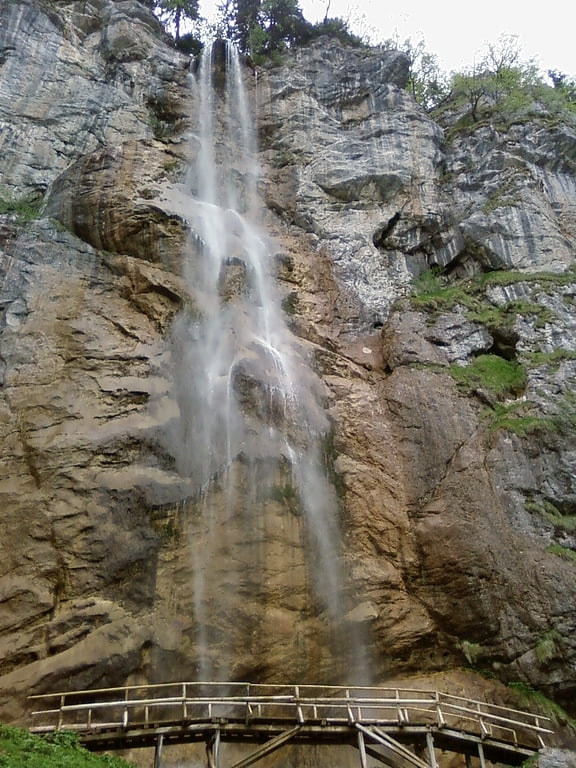
Waterfall in Bosnia and Herzegovina. Skakavac is a waterfall in Bosnia and Herzegovina. It is 12 kilometres northeast of Sarajevo, above the village of Nahorevo. At 98 metres, it is one of the tallest waterfalls in the Balkans and traverses a vertical limestone face. The waterfall freezes in winter into a number of shapes. Part of a stream of the same name, it flows below the peak of the 1,532-metre Bukovik into Perak Creek. Vegetation around the waterfall consists of endemic and relict plants. Nearby trails are frequented by mountain bikers and hikers. In 2002, the waterfall and its surroundings were declared a natural monument by the Sarajevo Canton government.[2]
Baščaršija, Sarajevo
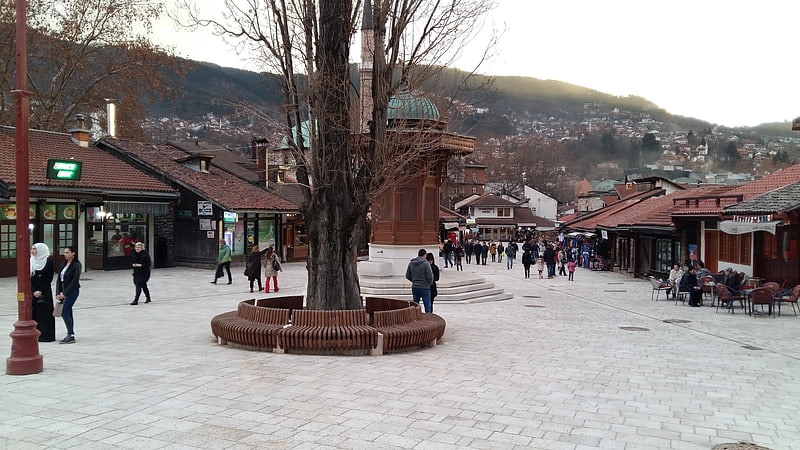
Historic market in the city center. Baščaršija is Sarajevo's old bazaar and the historical and cultural center of the city. Baščaršija was built in the 15th century when Isa-Beg Ishaković founded the city.
Baščaršija is located on the north bank of the river Miljacka, in the municipality of Stari Grad. On Baščaršija there are several important historic buildings, such as the Gazi Husrev-beg Mosque and sahat-kula. Today Baščaršija is the major tourist attraction of Sarajevo. Baščaršija local community (mjesna zajednica) is home to 1,790 residents.[3]
Stari Most, Mostar
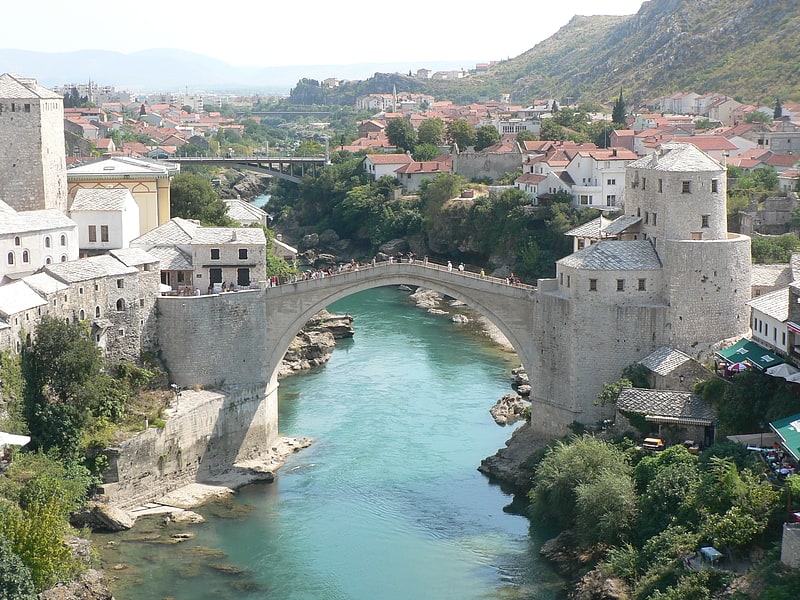
Also known as: Stari most
Landmark arched bridge built in 1566. Stari Most, also known as Mostar Bridge, is a rebuilt 16th-century Ottoman bridge in the city of Mostar in Bosnia and Herzegovina that crosses the river Neretva and connects the two parts of the city. The Old Bridge stood for 427 years, until it was destroyed on 9 November 1993 by Croatian Defence Council during the Croat–Bosniak War. Subsequently, a project was set in motion to reconstruct it; the rebuilt bridge opened on 23 July 2004.
The bridge is considered an exemplary piece of Balkan Islamic architecture and was commissioned by Suleiman the Magnificent in 1557. It was designed by Mimar Hayruddin, a student and apprentice of architect Mimar Sinan who built many of the Sultan's key buildings in Istanbul and around the empire.[4]
Address: Stari most, 88000 Mostar
Banski Dvor, Banja Luka
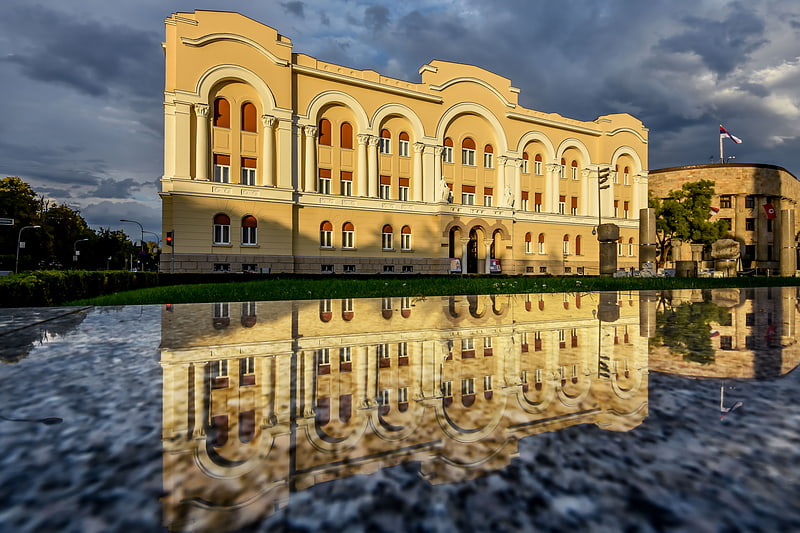
Also known as: Palata banskog dvora
Banski Dvor is a building and cultural center in Banja Luka. It was built in the period 1931-32 as the seat of Duke of Vrbas Banovina, an administrative region of the Kingdom of Yugoslavia.[5]
Address: Trg Srpskih Vladara 2, 78000 Banja Luka
Croatian National Theatre in Mostar, Mostar
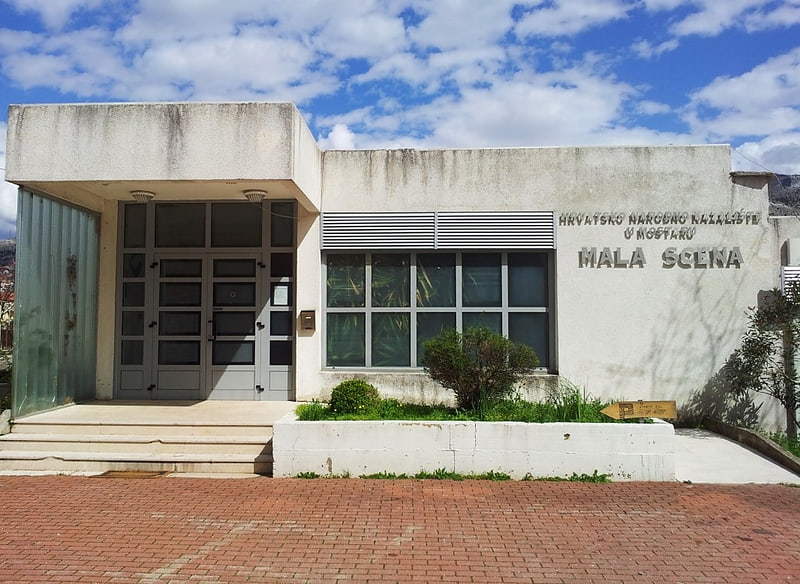
Theatre in Mostar, Bosnia and Herzegovina. The Croatian National Theatre in Mostar is a theatre located in Mostar, home to the largest population of Croats in Bosnia and Herzegovina.
HNK Mostar was established on September 22, 1994 and the foundations of its building were laid on January 30, 1996. In July 2011 the building was still undergoing construction and was incomplete. Croatian and local dramas are performed on the small stage in the basement (which is completed) and it is also the venue of the Croatian Puppet Theatre. Some of its goals include the promotion of Croatian culture in Bosnia and Herzegovina and abroad, as well as hosting international theatre troupes. All of its plays and performances are held on the small stage located in the building's basement. Half of its funding comes from the budget of Herzegovina-Neretva Canton (50%), while the other half comes from sponsors and donors. It currently has 25 employees and its theatre director (as of September 3, 2014) is Ivan Vukoja.[6]
Pliva Waterfall, Jajce
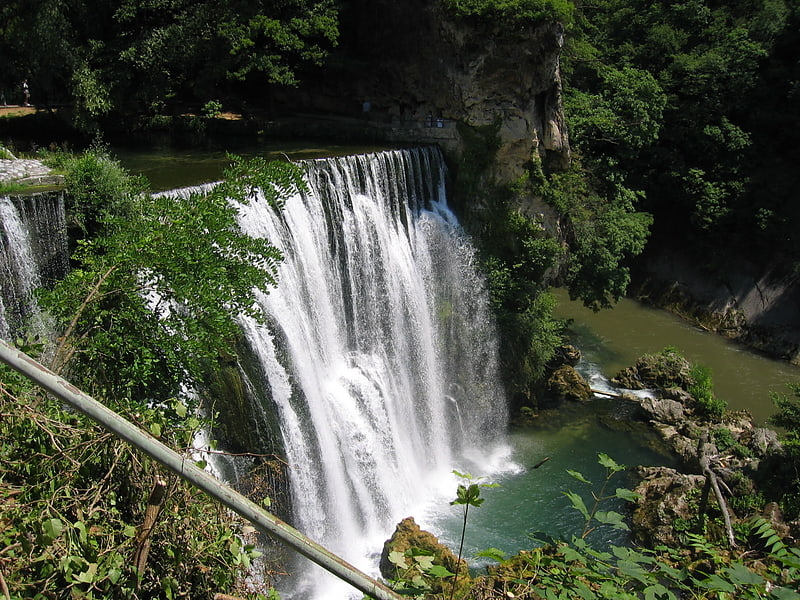
Waterfall in Bosnia and Herzegovina. The Pliva Waterfall is located by the town of Jajce, in central Bosnia and Herzegovina, where the river Pliva meets the river Vrbas. The waterfall is a large tufa, also known as travertine barrier, making over 22 meters cascade on the Pliva river, in a narrow karstic zone, which follows the Pliva course, retracted into a flysh and limestone contact zone. It was 30 meters high, but after an earthquake during the Bosnian war and attacks on the power plant further up the river, the area was flooded and now the waterfall is 22 meters high.
The old Jajce walled city core, including the waterfall, and other individual sites outside the walled city perimeter, such as the Jajce Mithraeum, is designated as The natural and architectural ensemble of Jajce and proposed for inscription into the UNESCO's World Heritage Site list. The bid for inscription is currently placed on the UNESCO Tentative list.[7]
Address: H.V. Hrvatinica, 70101 Jajce
Karađoz Bey Mosque, Mostar

Also known as: Karađoz-begova džamija
16th-century Ottoman-style mosque. Karađoz Bey Mosque is a 16th-century Ottoman mosque in the city of Mostar, Bosnia and Herzegovina.
With its big dome and high minaret it is one of the largest mosques in the region.[8]
Cathedral of Christ the Saviour, Banja Luka
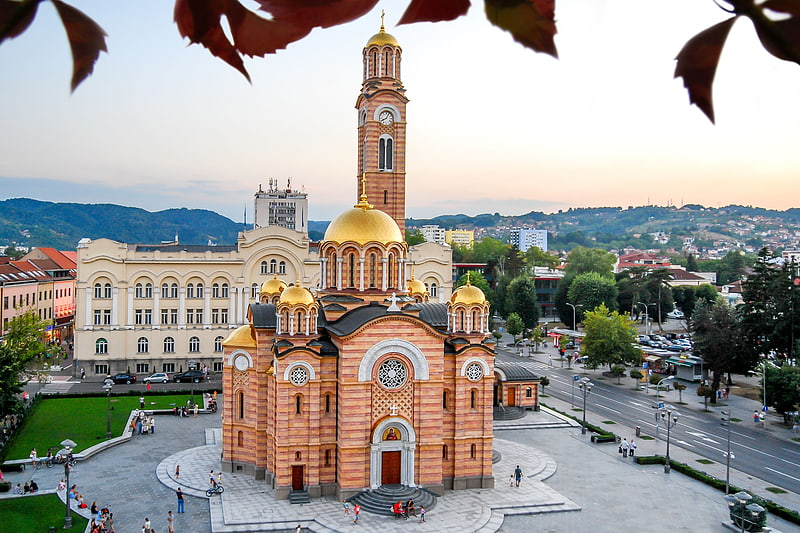
Orthodox church in Banja Luka, Bosnia and Herzegovina. The Cathedral of Christ the Saviour is a Serbian Orthodox church located in Banja Luka, Republika Srpska, Bosnia and Herzegovina.
A Holy Trinity Church was built during interwar Yugoslavia in the center of Banja Luka. The construction of the temple lasted from 1925 to 1929, and was solemnly consecrated on the Day of Salvation in 1939. During the German bombing on April 12, 1941, the temple was hit and the altar section (apse) was significantly damaged. In May of the same year, the Ustashas declared the temple a "mound of the city" and ordered the Serbs, Jews and Roma to completely demolish it, brick by brick.
During socialist Yugoslavia, while many buildings were rebuilt, the demolished Cathedral was not allowed to be reconstructed. During the Bosnian war, Eparchy of Banja Luka was granted permission for the destroyed temple to be rebuilt, and the monument to fallen soldiers was moved to a nearby site, also owned by the church. The erection of the new temple began in 1993 when the foundations were sanctified. This solemn act was performed by Serbian Patriarch Pavle with the bishops and clergy of the Serbian Orthodox Church. The temple was rebuilt under the name of the Cathedral of Christ the Savior, because, in the meantime, a temple was named after the Holy Trinity in Banja Luka (1963-1969), as a memorial to the demolished one, which the Orthodox Serbs thought would never be able construct again.
The cathedral is built of red and yellow travertine stone, originating from Mesopotamia, whose quality (excavation and processing) is guaranteed by prof. Dr. Bilbija, an expert from the Belgrade Institute for Material Testing. It is built with a three-layer wall: stone, reinforced concrete, brick. The domes are covered with golden stainless steel, brought from Siberia. Exterior construction work on the temple was completed on September 26, 2004, when the first liturgy was also served. The liturgy was served by 8 bishops with the clergy and deacons of the Diocese of Banja Luka, with the presence of tens of thousands of believers.
The present temple is architecturally identical to the previous one and is the tallest religious building in Banja Luka, with a bell tower 47 meters high and a 22.5 meter dome. The Bishop's Temple was consecrated by Bishop Ephrem on Salvation Day in 2009.
On the occasion of the 20th anniversary of the founding and celebration of the Day of Republika Srpska, Patriarch Irinej served the Holy Blessed Liturgy in the temple on January 9, 2012.[9]
Address: Trg srpskih vladara 3, 78000 Banja Luka
Kastel, Banja Luka
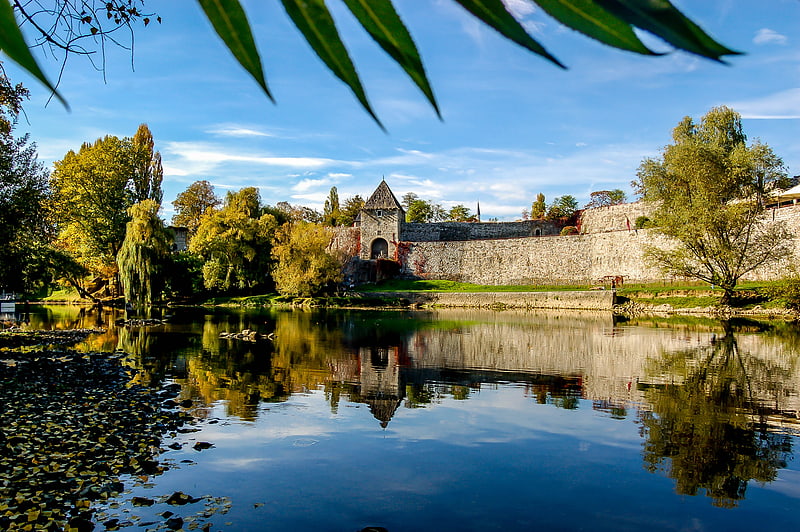
Historical place in Banja Luka, Bosnia and Herzegovina. The Kastel Fortress is a fortress located in Banja Luka, Bosnia and Herzegovina. The fortress is medieval but is situated on the site of previous fortifications going all the way back to Roman and even pre-Roman times. The fortress is relatively well-preserved, and is one of Banja Luka's main attractions, situated on the left bank of the Vrbas river in the very center of town.[10]
Hercegovačka Gračanica, Trebinje
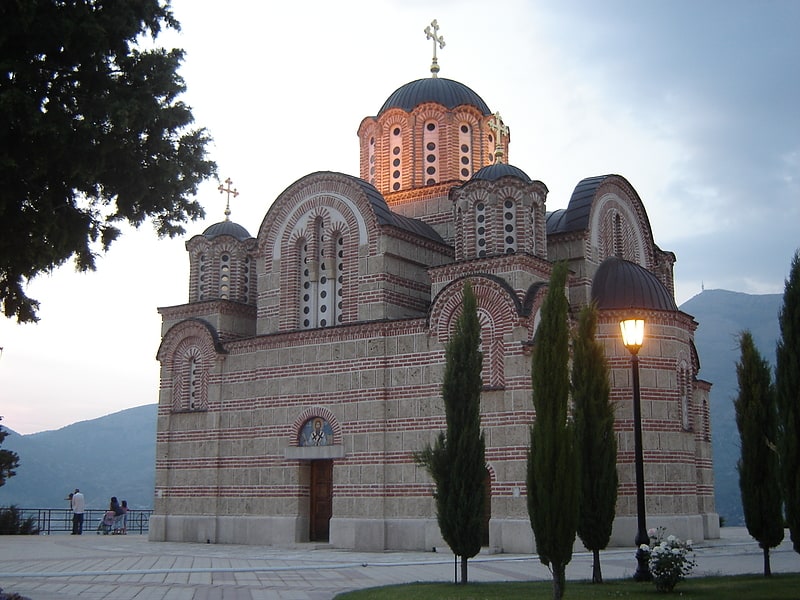
Monastery in Trebinje, Bosnia and Herzegovina. The Hercegovačka Gračanica Monastery is a Serbian Orthodox monastery located in Trebinje, in Bosnia and Herzegovina.
Largely a copy of the Gračanica monastery in Kosovo, it was completed in 2000. The monastery is located above the city, on the historic Crkvina Hill, and is dedicated to the Virgin Mary.[11]
Pliva River, Jajce
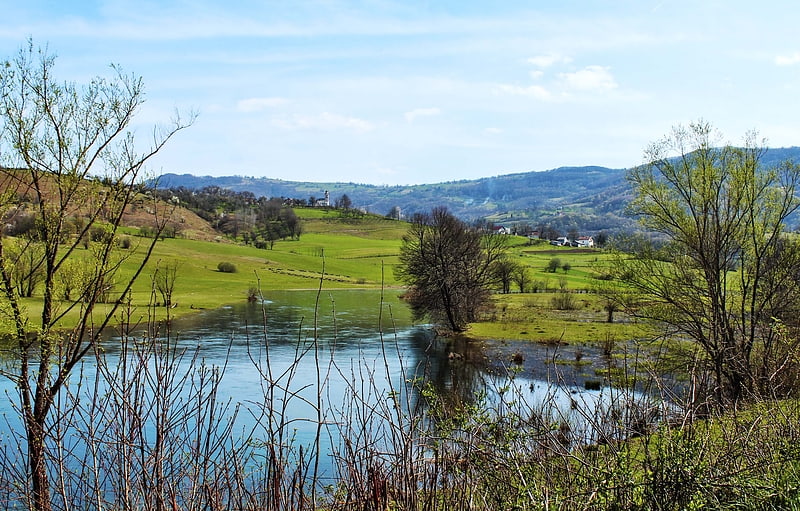
Also known as: Pliva
River in Bosnia and Herzegovina. The Pliva is a relatively small river in central parts of Bosnia and Herzegovina, however one of the most significant in terms of natural, cultural and historical heritage and value as a natural rarity. For hundreds of years this region was the ultimate stronghold of the Bosnian Kingdom, with the town of Jajce as permanent seat of the last kings of the Bosnian Kingdom.
The entire region of Jajce is rich in natural heritage that cannot be viewed in isolation from the built heritage. In Jajce, these two components are closely intermingled.[12]
Tvrdoš Monastery, Trebinje
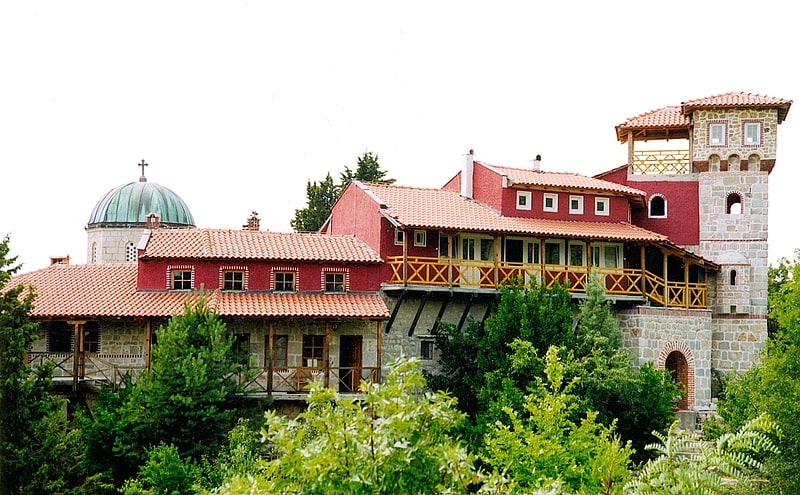
Monastery in Bosnia and Herzegovina. The Tvrdoš Monastery is a 15th-century Serbian Orthodox monastery near the city of Trebinje, Republika Srpska, Bosnia and Herzegovina. The 4th-century foundations of the first Roman church on the site are still visible.
The monastery, which is dedicated to the Dormition of the Most Holy Theotokos, was established during the 15th century, with a cathedral constructed around 1508 and painted with murals by Vicko Lavrov from Dubrovnik in 1517. The monastery remained a seat of the Metropolitans of Herzegovina until the Venetian Empire destroyed it in 1694. The current monastery building was constructed in 1924. Today, the monastery is renowned for its wine production (in particular from the local Vranac and Žilavka grape varieties) and its wine cellars, one of which dates to the 15th century, which are a popular tourist attraction.
As of late 2016, the monastery remains on the Provisional List for status as a National Monument of Bosnia and Herzegovina.
On 6 March 2021, the retired Bishop of Zahumlje and Herzegovina (1992–1999), Atanasije was buried in the Chapel of the Resurrection of the Lord in the cemetery of the monastery.[13]
Pannonian Lakes, Tuzla

Panonsko Lake is an artificial lake of Bosnia and Herzegovina. It is located in the municipality of Tuzla. This lake is commonly used as a leisure spot by both tourists and locals alike.[14]
Arslanagić Bridge, Trebinje

Also known as: Arslanagića most
Arch bridge in Trebinje, Bosnia and Herzegovina. Arslanagić Bridge, also known as Perović Bridge, is a bridge in the municipality of Trebinje, Bosnia and Herzegovina, and since 25 January 2006 a National Monument of Bosnia and Herzegovina.[15]
Walled city of Jajce, Jajce
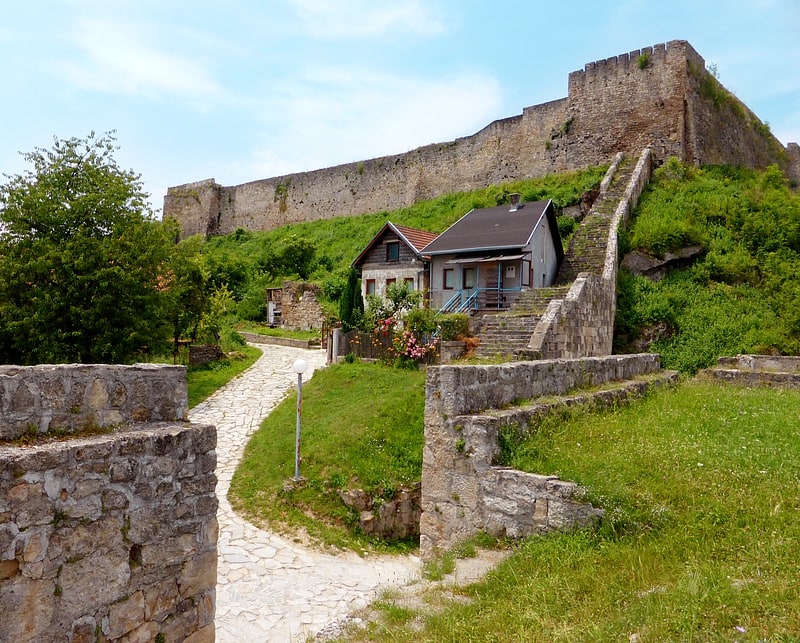
Fortress in Jajce, Bosnia and Herzegovina. The Walled City of Jajce is a medieval fortified nucleus of Jajce in Bosnia and Herzegovina, with citadel high above town on top of pyramidal-shaped steep hill, enclosed with approximately 1,300 metres long defensive walls,. It is one of the best preserved fortified capitals of the Bosnian Kingdom, the last stronghold before the kingdom dissolved under the pressure of military advancement at the onset of Ottoman Empire takeover.[16]
Address: Old Town Jajce, 70101 Jajce
Donje Bare, Sutjeska National Park

Lake in Bosnia and Herzegovina. Donje Bare is a natural lake in Bosnia and Herzegovina, on the mountain Zelengora. It is located below the Ardov peak. It is 250 metres long and 120 metres wide. The greatest depth of the lake is 4.5 metres.
During the winter, the lake is completely ice-bound. Rainbow trout is an invasive species that lives the lake. The water is clean and clear. It is filled with sources springing on the west coast. The bottom is dark blue. Around the lake are meadows and forests, a landscape of alpine pastures, covered with mountain grass, interspersed with scrub and pine trees, and in lower areas of beech.[17]
Atik Behram-begova džamija, Tuzla

Mosque in Tuzla, Bosnia and Herzegovina. The Atik Behram-begova džamija, better known as Šarena džamija, is the oldest mosque in Tuzla, Bosnia and Herzegovina.[18]
Address: Atik mahala, 75000 Tuzla
Skakavac Waterfall, Sutjeska National Park
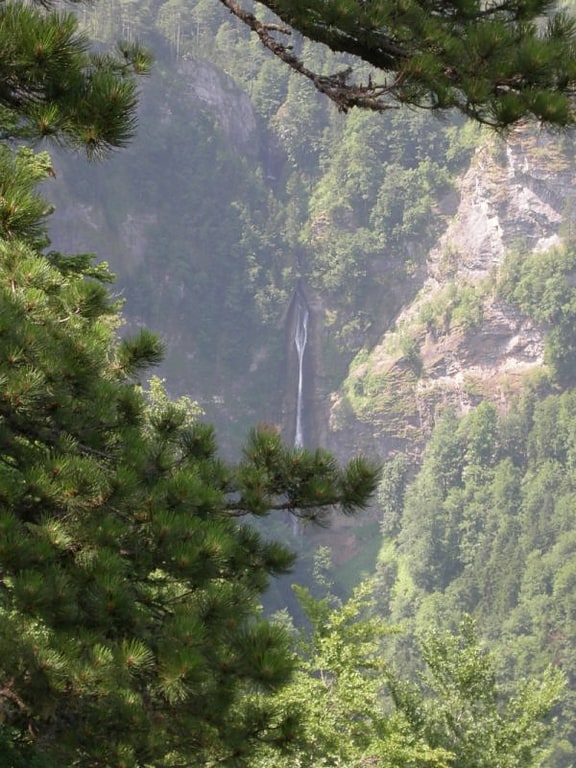
Also known as: Vodopad Skakavac
Waterfall. Skakavac is a waterfall formed on the Perućica, a mountain creek, in the Perućica, which is regulated as a Strict Nature Reserve as part of Sutjeska National Park in Republika Srpska, Bosnia and Herzegovina. It is one of the highest waterfalls in the country, at about 75 metres in height.
The Perućica primeval forest of beech and spruce is situated beneath Maglić (2,386 m), the highest peak in Bosnia and Herzegovina, and separated from Zelengora mountain by the canyon of the Sutjeska river. Perućica creek cuts through the Perućica forest and descends between two steep Maglić slopes. Near the middle of its course, the stream cascades from the upper hanging valley to the lower valley, falling 75 meters from a karstic limestone precipice to reach its confluence with the Sutjeska river in the valley of Tjentište.[19]
Perućica, Sutjeska National Park

National park in Tjentište, Bosnia and Herzegovina. Perućica is one of the last remaining primeval forests in Europe. It is located in Bosnia and Herzegovina, near the border with Montenegro. It is part of the Sutjeska National Park.
Perućica Forest Reserve is 6 kilometres (3.7 mi) long, 1–3 kilometres (0.62–1.86 mi) wide, and has an area of 1,400 hectares (3,500 acres). It is a UNESCO recognized site. The forest has many trees that are 300 years old, and the primeval forest's vintage is stated to be 20,000 years. In some stretches the forest growth is almost impenetrable, and the forest can only be explored in the company of rangers.[20]
Blidinje Lake, Blidinje
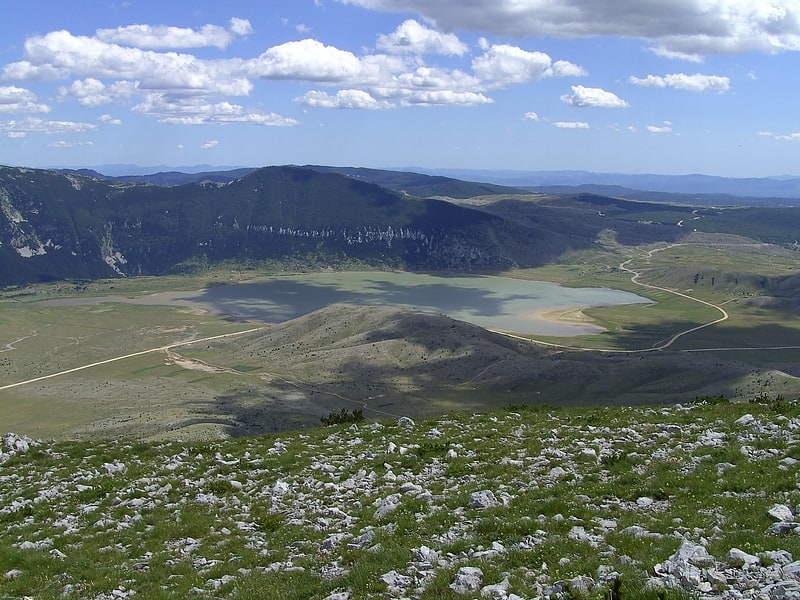
Also known as: Blidinje jezero
Alpine lake in Bosnia and Herzegovina. Blidinje Lake, is alpine lake located in Blidinje Nature Park, on karstic Blidinje plateau, Bosnia and Herzegovina, between Jablanica, Tomislavgrad and Posušje, and is largest of its kind in the country. The lake is most important hydrogeological feature of the park and indeed entire Dinaric Alps karst within Bosnia and Hezegovina.[21]
Visočica hill, Visoko
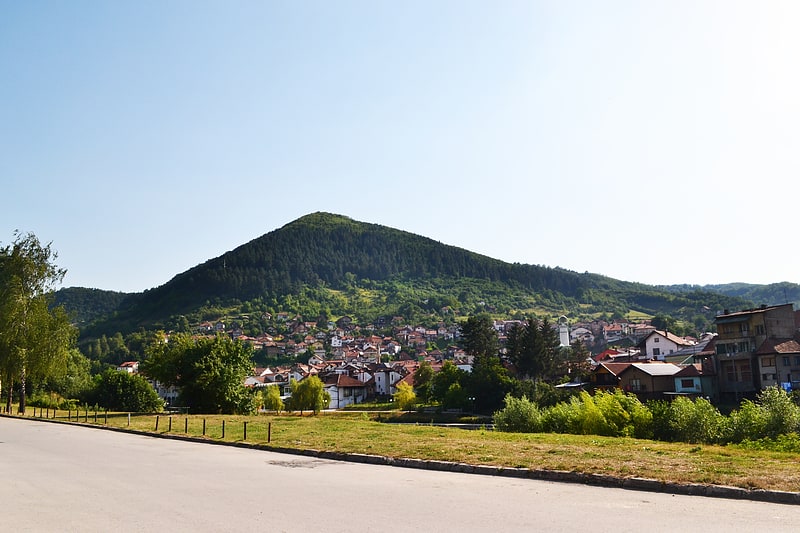
Also known as: Visočica
Hill in Bosnia and Herzegovina. Visočica (also known as Brdo Grad is a 213-metre-high hill in Bosnia and Herzegovina famous as the site of the Old town of Visoki.
The hill has for more than a decade been the subject of a pseudoarchaeological belief that it is part of an ancient man-made pyramid complex. This notion is rejected by Western archaeologists and geologists.[22]
Old town of Visoki, Visoko

Also known as: Stari grad Visoki
Fortress in Bosnia and Herzegovina. The Old Town of Visoki was a medieval royal castle town built during the 14th century on the top of the hill overlooking town of Visoko, Bosnia and Herzegovina. The first mention of the town was on 1 September 1355, in the charter "in castro nosto Visoka vocatum" written by Tvrtko I of Bosnia while he was a young ban. The town was abandoned before 1503, because it is not mentioned in the Turkish-Hungarian treaty from the mentioned year. In 1626, Đorđić mentioned Visoki among abandoned towns.[23]
Prenj, Blidinje
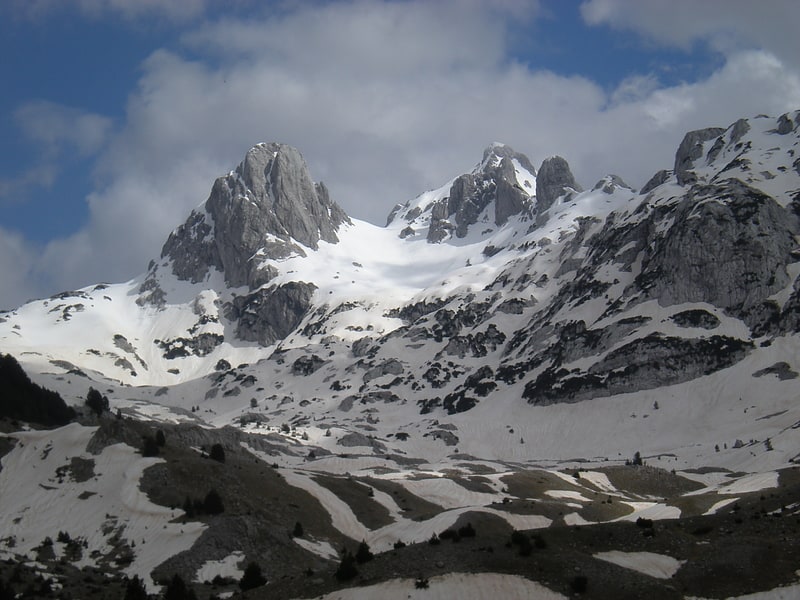
Mountain range in Bosnia and Herzegovina. Prenj is a mountain range in the Dinaric Alps of southern Bosnia and Herzegovina, located in eastern Herzegovina near Mostar, Jablanica and Konjic. The highest peak is Zelena glava at 2,115 m. Prenj massif has at least 11 peaks over 2000 m.[24]
Čvrsnica, Blidinje
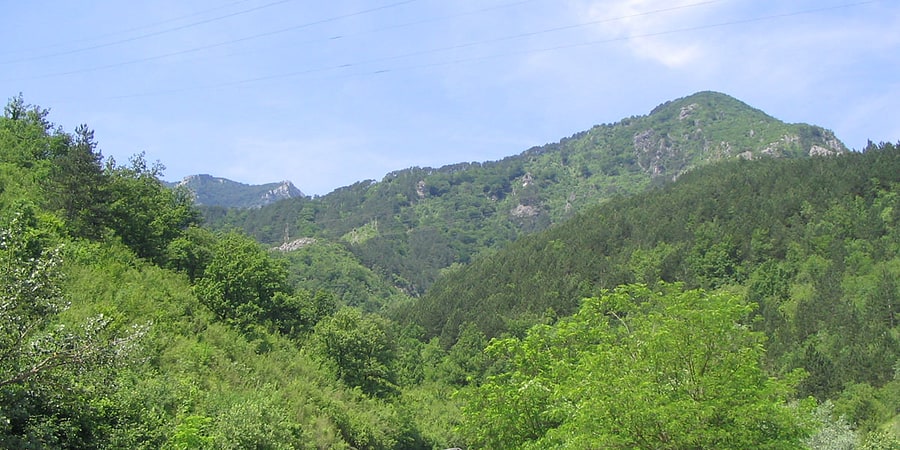
Mountain in Bosnia and Herzegovina. Čvrsnica is a mountain in the Dinarides of Bosnia and Herzegovina, located in northern Herzegovina. Most of the mountain is located in the Herzegovina-Neretva Canton municipalities of Mostar and Jablanica, while the smaller part of the mountain, around 10% is located in the municipality of Posušje. The highest peak is 2228 metres.
Čvrsnica is surrounded by the river Neretva from the east (20 km), its tributaries Doljanka (18 km) from the north and Drežanka (19.8 km) from the south, the Dugo Polje field (12 km) and Vran mountain from west. The mountain consists of several plateaus — Plasa and Muharnica on north, Mala Čvrsnica on south. There are more than ten summits above 2000 m (Pločno 2228 m, Veliki Jelinak 2179 m, Veliki Vilinac 2118 m, etc.), vertical cliffs (Pesti brdo, Mezica stijene, Strmenica...). It also includes lakes of Blidinje, Crepulja and Crvenjak. The Diva Grabovica canyon (6.2 km) goes into the mountain.
Bio-life is characteristic of its three climate areas: conifers above 1200 m, plateau with grass and junipers; numerous endemic species (like Munika Pine). Čvrsnica is well known as a home of chamois.[25]